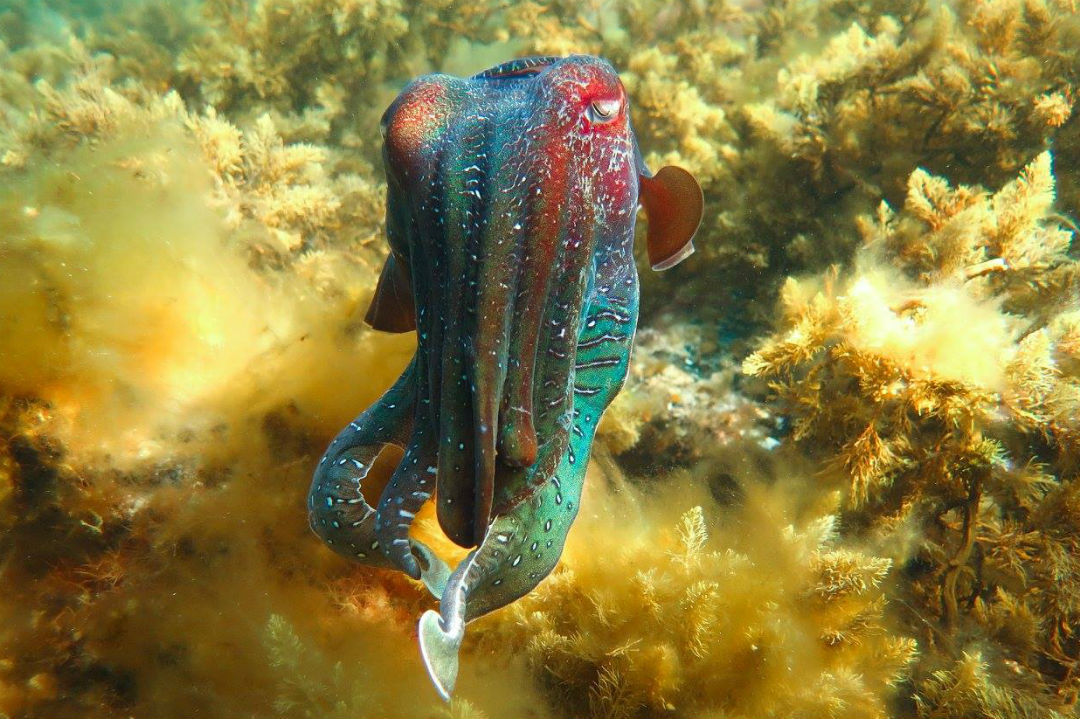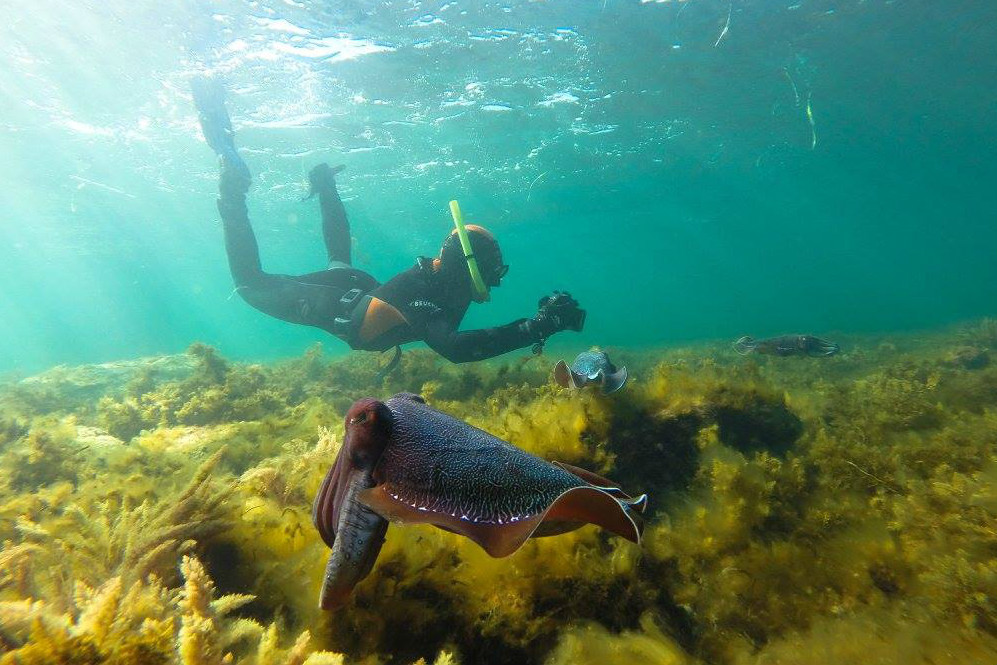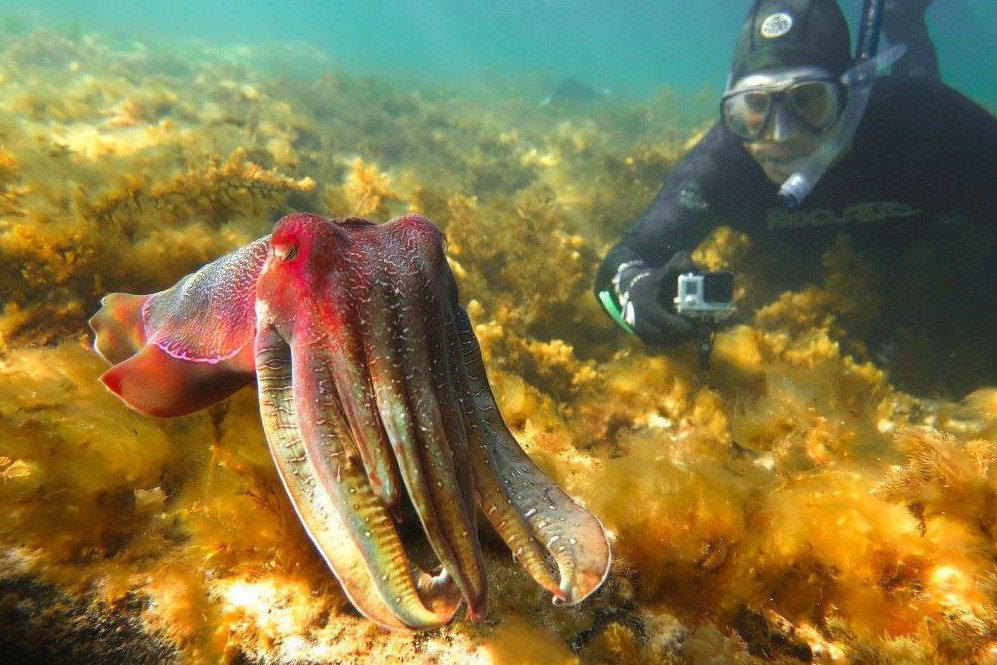
Everything you need to know about giant Australian cuttlefish in South Australia
Every winter thousands of giant Australian cuttlefish congregate in SA. Learn where, why and how to swim with them.
The giant Australian cuttlefish is exactly what its name suggests – the largest of all the cuttlefish species. Males can be particularly big in size and measure up to 50 cm long and weigh about 10 kg.
These intelligent creatures are expert colour-changers and masters of camouflage, and can change shape and texture to look like rocks, sand or seaweed – a spectacular sight to see.

Giant cuttlefish can be found all along Australia’s Great Southern Reef within the temperate waters from the the east-coast of Queensland, and on the west-coast up to Ningaloo Reef in Western Australia.
However the population found within the Northern Spencer Gulf is unique to this area, not inter-mixing with the population further south or along the wider Great Southern Reef.
This Northern Spencer Gulf population of Giant Australian cuttlefish congregate off the coast of Whyalla in South Australia, along a 10 km stretch of the Upper Spencer Gulf Marine Park. Cuttlefish numbers usually increase throughout May and peak in June and July when the breeding season is in full swing.
So if you’re heading to Whyalla or Spencer Gulf, head to the Cuttlefish Coast to get a glimpse of these majestic creatures.
Why do giant Australian cuttlefish aggregate near Whyalla?
SA’s waters are the only place in the world where the cuttlefish congregate annually en mass and with such great predictability. Their sole purpose? Breeding! Their underwater light shows, cunning games and dramatic colour displays are all to lure a mate (or mates!) for breeding.
Whilst giant Australia cuttlefish breed annually in small groups along the Great Southern Reef, those in Northern Spencer Gulf aggregate in large numbers – something not seen anywhere else in the world.
The waters around Point Lowly and Stony Point in the Upper Spencer Gulf Marine Park have rocky seabeds, which provide the perfect environment for females to lay and delicately attach their eggs.
The sheer number of cuttlefish makes the Whyalla breeding season aggregations unique, not just in Australia, but in the world. For this reason, the Cuttlefish Coast Sanctuary Zone was awarded National Heritage status in 2023.
Why the colourful show?
As part of the breeding process, male cuttlefish outnumber females, sometimes 7:1 — so they make it a point to look absolutely stunning. They put on a spectacular display of colours and shape-shifting to attract and keep a mate. Kind of like a dance-off!
How can you experience the cuttlefish?
The Whyalla City Council celebrate the cuttlefish breeding aggregation each year with the annual festival – Cuttlefest. There are numerous ways to learn about experience and enjoy the cuttlefish as part of this program.
For those wanting experience giant Australian cuttlefish up-close in waters around Point Lowly and Stony Point, also known as Cuttlefish Coast, there are several options.

You can go at it alone and snorkel or dive yourself. Or you can take a guided snorkel, dive or even glass bottom bottom boat tour. Theres even glass bottom kayaks to hire!
The main site with visitor amenities and the site for guided tours is at Stony Point, about 20 km northeast of Whyalla. There’s easy access via a boardwalk to the shallow water and a waist-height chain to hold onto for support, making it the safest point to enter or exit. For those entering the water, just make sure you head across to the snorkel and dive safe zone delineated by marker buoys, to ensure you stay away from boat traffic.
Read all about what it’s like to swim with giant Australian cuttlefish here.
Top tip: Experiencing Marine Sanctuaries offer guided snorkel tours and Whyalla Dive Servicesboth guided snorkel and dive tours. Spencer Gulf Adventuresoffer a glass bottom kayak experience and both Cutty’s Tours and Spencer Gulf Adventures offer glass bottom boat experiences.
What should you wear?
In the winter months, the water is cold so a well-fitting full length 5 mm or 7 mm thick wetsuit with hood, gloves, boots and a mask and snorkel is the way to go. Fins are also important, as the currents can get strong along that part of the coastline. If you haven’t got your own gear you can always hire it from Whyalla Diving Services.
Top tip: Prefer to see these majestic wonders without getting a foot wet? There’s also two glass-bottomed boat experiences you can try.
Do the cuttlefish care that you’re there?
The sheer size and quick colour-changing behaviour of the cuttlefish can be intimidating at first, but after a few minutes you realise they only have one thing on their mind – finding a mate!
If you’re careful to move slowly, you can get up close without disturbing the cuttlefish. They seem oblivious to people and are focused on breeding.
But remember to respect their space – look but don’t touch. If they react to your presence, ensure your retreat. After all, its next years population that are being produced at this time.

Are cuttlefish safe to swim near?
Snorkelling is safe along Point Lowly and Stony Point, but you do need to be careful when entering water over rocks and boulders, as they can be unstable and slippery.
Its also important to ensure that you follow local safety signage and directions – only snorkel or dive within the safety zone at Stony Point, go with a buddy and keep an eye out for boats and other hazards.
Top tip: You can sometimes find cuttlefish in less than a metre of water.
If you’d rather learn about the underwater creatures hanging out in SA’s waters from the comfort of dry land, check out our blogs about sea dragons, blue devil fish and squid.
Learn more about the science, stats and conservation of these giant cuttlefish — Giant Autralian Cuttlefish | Great Southern Reef
Educational Resources
Are you an educator wanting to incorporate Giant Australian Cuttlefish learning in the classroom? Check out this new resource from our friends at the Great Southern Reef: Interactive Lesson Series: Giant Australian Cuttlefish | Great Southern Reef
(Main image courtesy of Jamie Hicks)
DEW newsletter: Sign up to get updates from DEW, direct to your inbox!